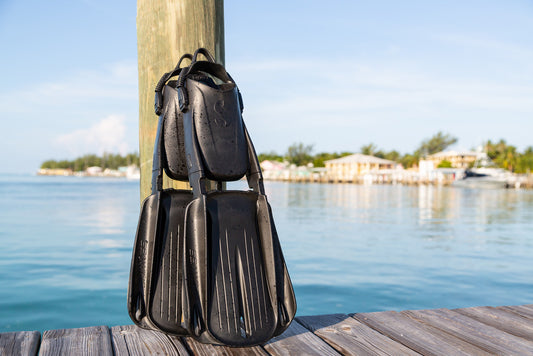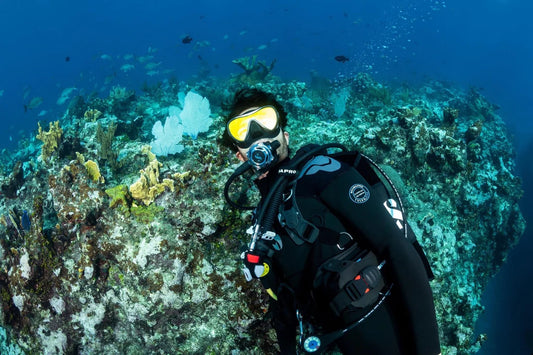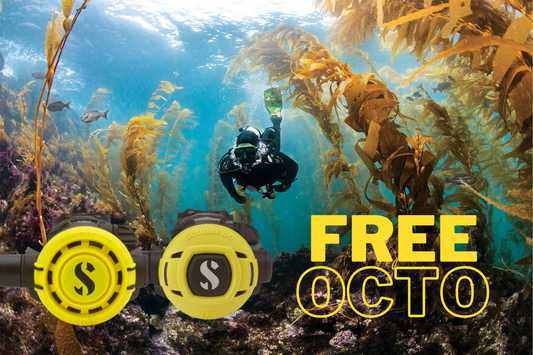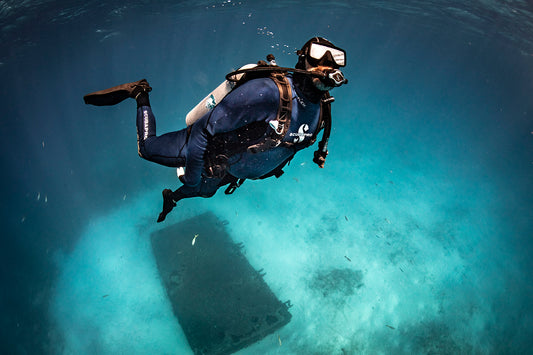Reg Valentine was an original founder of the British Sub-Aqua Club and for many years operated a dive centre on the Italian island of Giglio, nowadays more famous for its modern tragic wreck of the cruise liner Costa Concordia. Reg was well known for logging all his dives in minute detail, written in a neat calligraphic hand in characteristic turquoise green ink. After a very long career, those logs must amount to very many bound volumes indeed.
Mensun Bound, an archaeologist was sitting in his dentist's waiting room when he spotted a rare Etruscan vase sitting on a shelf. He asked his dentist where it came from. It seemed that the dentist was a scuba diver and took vacations every year in Giglio. Divers there often dived an ancient wreck site where such vases could be found.
That's how the Giglio wreck came to be put on the map. Dating from around 600BC, it was one of the most important marine archaeological sites ever discovered. The problem was that it had been naïvely yet systematically plundered by leisure divers over the years and many of the valuable artefacts were by then in private hands. If it had not been for Reg's meticulous log-keeping, none of those artifacts would have been recovered to the museum where they belonged. In fact all but one diver handed over their trophies apart from the man that retains an important Etruscan soldier's helmet in his bank vault in Germany.
When I started diving, I too kept meticulous records of every leisure dive. It was later as a dive guide on a liveaboard that I reached dive No. 1000 and realised that the second thousand was going to take just as long to do and I lost interest. I still have those diving logbooks but rarely look at them. I certainly don't spend winter evenings browsing in a self-satisfied way through records of dives I've done the previous year. We now call this an analogue system.
Whether we like it or not, the silicone chip has taken over our lives. I still drive my car from A to B as I have always done but now I am bombarded with information regarding my average speed, my fuel consumption by average and from moment to moment, my prospective range on what's left in my tank and so on. I'm not sure I actually need it. What I need is a car that is reliable and gets me to where I'm going just as my dad always did before me.
When I first started using a dive computer in the late '70s I met with a lot of vociferous objection from older divers who did not trust this new-fangled technology.
Today, we all use diving computers and virtually all of them allow the dives we record to be downloaded to a home computer or laptop given the right interface and software. The downloaded information includes a time/depth graph together with things like water temperature and a graphic representation of the tissue-loading of the token model tissues employed by the computer's algorithm. Of course, this is not actually your own specific tissue-loading.
Diving has also changed in that many divers now are so engrossed in the technical challenge of doing a deep dive and coming back successfully that when asked, "What did you see while you were down there?" can only answer with such things as breathing mixes, run-times and deco-stop durations.
No doubt these new technical divers spend hours pouring over dive profiles and marvelling at their proficiency at achieving depths unthinkable to the likes of Reg Valentine in his prime, yet coming back hopefully undamaged by the pressures encountered while doing it.
Of course, some do suffer decompression injuries and the time/depth graph provided plus the ancillary information can go some way to offering an explanation as to what might have happened.
I'm rather old-fashioned in that I go diving for the experience of encountering what is down there. I use my computer (usually with a back-up) to reduce the risk of decompression injury and I'm pleased to say that after all these years I appear to have got away with it. Some people are less lucky.
More tragically, David Graves, a well-known journalist working for a British broadsheet newspaper, drowned on the first day of a press trip to the Bahamas. I was present at the time and was very much involved in the recovery of his body and the sadly unsuccessful attempts to resuscitate him. He was wearing a computer watch.
Of course I, among others, was acutely interested to know what were the circumstances of his untimely demise. I downloaded his last dive from the computer he had been wearing on his wrist. It was probably illegal for me to do so.
Later, the newspaper got involved in an attempt to bring a manslaughter charge against the dive centre with which we had both been diving and I found myself enduring a six-hour cross examination in the witness box.
It so happened that the newspaper had commissioned a technical expert to investigate what had happened to their man. He too downloaded the profiles of the two dives the deceased had made on that solitary first day of diving. I know this because by co-incidence I happened to share an office with the said technical expert.
The downloaded dive-profile from his computer told the whole story of what had happened. The deceased had swum off alone, run out of air, made a fast ascent to the surface where he could have stayed had he dropped his weightbelt or orally inflated his BC but, alas, he dropped and drowned.
The newspaper concerned wanted to make more of a meal of it than that. When the Coroner asked the lawyer representing the widow of the deceased for a print-out from his computer, he was disingenuously told it would take around three months. It took me only minutes to download but of course I was unable to reveal I had that information in Court since the computer information was not legally mine to possess.
However, the computer on your wrist or console acts as the 'black box' of an aircraft. In the event of a bend or even should the unthinkable happen, it will be full of useful information. Not only that but I believe that the diving computer, when used correctly and by someone who understands the information it disseminates, has done almost more than any other item of diving equipment to add safety to what we do.
We also now live in the age of apps. It's reaching the point when a Bluetooth connection will allow us to download a dive profile from our computer to our mobile device and/or tablet and send it to the Cloud for storage or to any interested party almost as soon as we have surfaced. In fact we can even house our mobile phones in a watertight housing and with the right app, use it as a diving computer.
If you like to write a comprehensive report of every dive in your logbook as I know many divers do, a print-out of the dive profile alongside it might enhance things. The big question is, do you need to routinely download every dive and examine the dive profile afterwards? My answer would be, "Do it if it makes you happy. I'll be too busy downloading my photographs!"
Happy Diving - John Bantin



